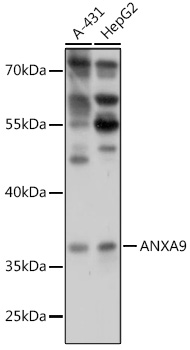Cell Biology Antibodies 13
Anti-ANXA9 Antibody (CAB17566)
- SKU:
- CAB17566
- Product Type:
- Antibody
- Reactivity:
- Human
- Host Species:
- Rabbit
- Isotype:
- IgG
- Antibody Type:
- Polyclonal Antibody
- Research Area:
- Cell Biology
Description
| Antibody Name: | Anti-ANXA9 Antibody |
| Antibody SKU: | CAB17566 |
| Antibody Size: | 20uL, 50uL, 100uL |
| Application: | WB |
| Reactivity: | Human |
| Host Species: | Rabbit |
| Immunogen: | Recombinant fusion protein containing a sequence corresponding to amino acids 1-100 of human ANXA9 (NP_003559.2). |
| Application: | WB |
| Recommended Dilution: | WB 1:500 - 1:2000 |
| Reactivity: | Human |
| Positive Samples: | A-431, HepG2 |
| Immunogen: | Recombinant fusion protein containing a sequence corresponding to amino acids 1-100 of human ANXA9 (NP_003559.2). |
| Purification Method: | Affinity purification |
| Storage Buffer: | Store at -20°C. Avoid freeze / thaw cycles. Buffer: PBS with 0.02% sodium azide, 50% glycerol, pH7.3. |
| Isotype: | IgG |
| Sequence: | MSVT GGKM APSL TQEI LSHL GLAS KTAA WGTL GTLR TFLN FSVD KDAQ RLLR AITG QGVD RSAI VDVL TNRS REQR QLIS RNFQ ERTQ QDLM KSLQ AALS |
| Gene ID: | 8416 |
| Uniprot: | O76027 |
| Cellular Location: | |
| Calculated MW: | |
| Observed MW: | 37kDa |
| Synonyms: | ANX31, ANXA9 |
| Background: | The annexins are a family of calcium-dependent phospholipid-binding proteins. Members of the annexin family contain 4 internal repeat domains, each of which includes a type II calcium-binding site. The calcium-binding sites are required for annexins to aggregate and cooperatively bind anionic phospholipids and extracellular matrix proteins. This gene encodes a divergent member of the annexin protein family in which all four homologous type II calcium-binding sites in the conserved tetrad core contain amino acid substitutions that ablate their function. However, structural analysis suggests that the conserved putative ion channel formed by the tetrad core is intact. [provided by RefSeq, Jul 2008] |
| UniProt Protein Function: | ANXA9: a calcium/phospholipid-binding protein that may act as a low affinity receptor for acetylcholine. Annexins are a family of structurally related proteins whose common property is calcium-dependent binding to phospholipids. There are at least ten different annexins in mammalian species. Annexins do not contain signal peptides, yet some annexins (A1, A2 and A5) appear to be secreted in a physiologically regulated fashion. |
| UniProt Protein Details: | Protein type:Lipid-binding; Calcium-binding Chromosomal Location of Human Ortholog: 1q21 Cellular Component: cell surface; cytosol Molecular Function:acetylcholine receptor activity; phosphatidylserine binding; phospholipid binding; protein binding; protein homodimerization activity Biological Process: cell-cell adhesion |
| NCBI Summary: | The annexins are a family of calcium-dependent phospholipid-binding proteins. Members of the annexin family contain 4 internal repeat domains, each of which includes a type II calcium-binding site. The calcium-binding sites are required for annexins to aggregate and cooperatively bind anionic phospholipids and extracellular matrix proteins. This gene encodes a divergent member of the annexin protein family in which all four homologous type II calcium-binding sites in the conserved tetrad core contain amino acid substitutions that ablate their function. However, structural analysis suggests that the conserved putative ion channel formed by the tetrad core is intact. [provided by RefSeq, Jul 2008] |
| UniProt Code: | O76027 |
| NCBI GenInfo Identifier: | 134047698 |
| NCBI Gene ID: | 8416 |
| NCBI Accession: | O76027.3 |
| UniProt Secondary Accession: | O76027,Q5SZF1, Q6FI55, Q9BS00, Q9HBJ6, |
| UniProt Related Accession: | O76027 |
| Molecular Weight: | 38,364 Da |
| NCBI Full Name: | Annexin A9 |
| NCBI Synonym Full Names: | annexin A9 |
| NCBI Official Symbol: | ANXA9 |
| NCBI Official Synonym Symbols: | ANX31 |
| NCBI Protein Information: | annexin A9 |
| UniProt Protein Name: | Annexin A9 |
| UniProt Synonym Protein Names: | Annexin XXXI; Annexin-31; Annexin-9; Pemphaxin |
| Protein Family: | Annexin |
| UniProt Gene Name: | ANXA9 |
| UniProt Entry Name: | ANXA9_HUMAN |







